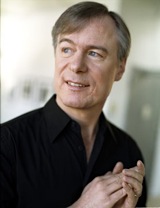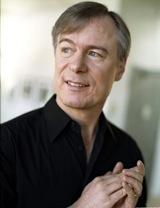George Benjamin, the orchestra’s Phyllis C. Wattis composer in residence for the month, supplied the essential connective tissue. From the opening tick of claves in his Jubilation, a 1985 work for a fully amped orchestra and children’s chorus, through the technicolor effects of Piano Figures (2004) that came just before intermission, listeners were witness to a series of kaleidoscopic alterations. Written for school orchestra, Jubilation gave Benjamin the self-imposed challenge, as he is quoted in the program, to “try to maintain my identity despite its simplicity.”

The forthright did indeed yield some Benjaminian dazzlement. As the regular claves began to stutter and soft, faraway moans emerged from the stage, a clotted chord seemed to signal a gathering tension. Sure enough, with an insistently repeated augmented seventh, the Crowden School Allegro Chorus rose as one on one on their terrace perch and let loose with their first exultant lines. A text, if there was one, was neither supplied nor discernible. Not that it mattered — immediacy, impact, and brightly colored clarity were the means of rejoicing here. Simplicity remained an asset when woodwinds and brasses both mimicked and slyly departed from the choral exclamations. Later on, in the same spirit of mutual reinforcement, some of the young singers clacked back on claves of their own. Jubilation was a fleet and cursory celebration, but it did offer a winning communal glow.
Next up were orchestrations of three of the original Twelve Etudes by Dubussy, piano pieces from 1915 that were transmuted by orchestrator Michael Jarrell in 1992. Even in a rather bland performance, Robertson found a humorous aplomb in the repeated notes of the first étude, and a shimmering mood in the second, as tendrils of woodwind melody curled up from the murmurous groundwater of the strings. In the third étude, “Pour les accords,” what was once a gaudy keyboard display become a showcase of orchestral flourishes and momentum.
As if in answer to the Debussy-Jarrell challenge, Benjamin’s Dance Figures served up its own form of bravura piano transcription. In ramping up his Piano Figures — which, like Jubilation, was composed for student players — the composer created a nine-movement perpetual-motion machine of shifting shapes, colors, and impressions. The strings were hushed and incantatory in “Spell,” liquidly glossy in “In the mirror,” and rueful in “Olicantus” (a poignant turn by principal cellist Michael Grebanier). The woodwinds had a chatty, loquacious outing in “Recit.” “Interruptions” featured snarling French horns and a thundering tuba. Violas and muted trumpets teamed up in a jaunty yet elegiac “Song.” The percussionists, who sat out the early movements, caught up in a big way in “Hammers.” And when else will one of them get to play a fishing reel?
It sounds (and was) frivolous in spots. But if the alchemy was flashy, it was also affirmative. Benjamin made the audience marvel anew at the glorious depth and variety of what an orchestra can do. Intentionally or not, the propulsive final movement, “Whirling,” echoed the clamor of the last Debussy-Jarrell étude. The string of connections in this artfully devised sequences of pieces doubled back and became stronger in retrospect.
The second half of the concert was devoted to a sturdily handsome and engaging, if occasionally restrained, account of Mendelssohn’s Symphony No. 3, “Scottish.” After a somber and somewhat drama-deprived opening statement, Robertson let the shafts of sunlight in. The first movement grew in pliancy and poise. The running melody of the Scherzo ran by (almost too quickly) like a rushing stream. The songlike Adagio soared from the sometimes perfunctory to the exquisitely tender, with Robertson exhibiting his most urgent body language of the night. The final movement had both majesty and a steely tensile strength, offset by a supple woodwind exposition in the middle. Even Mendelssohn’s flair for weak endings didn’t diminish this fine conclusion.

